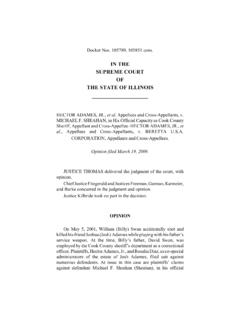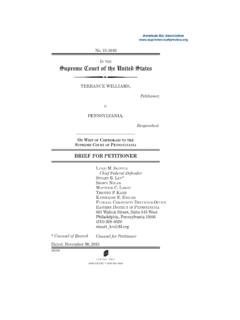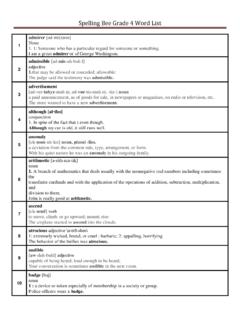Transcription of FILED United States Court of Appeals PUBLISH Tenth Circuit ...
1 PUBLISH United States Court OF Appeals FOR THE Tenth Circuit _____ MARY ANNE SAUSE, Plaintiff - Appellant, v. TIMOTHY J. BAUER, Chief of Police; JASON LINDSEY, Police Officer of Louisburg, Kansas; BRENT BALL, Police Officer of Louisburg, Kansas; RON ANDERSON, Former Chief of Police of Louisburg, Kansas; LEE STEVENS, Former Louisburg, Kansas Police Officer; MARTY SOUTHARD, Mayor of City of Louisburg, Kansas; TRAVIS THOMPSON, Former Mayor of City of Louisburg, Kansas, Defendants - Appellees. No. 16-3231 _____ Appeal from the United States District Court for the District of Kansas ( No. 2:15-CV-09633-JAR-TJJ) _____ Bradley G. Hubbard, Gibson, Dunn & Crutcher LLP, Dallas, Texas (James C. Ho, Gibson Dunn & Crutcher LLP, Dallas, Texas, Hiram S. Sasser III, Justin E. Butterfield and Stephanie N. Phillips, First Liberty Institute, Plano, Texas, and Jason Neal, Gibson, Dunn & Crutcher LLP, Washington, , with him on the briefs), for Plaintiff-Appellant.
2 Christopher B. Nelson, Fisher, Patterson, Sayler & Smith, LLP, Overland Park, Kansas (Michael K. Seck and Amy J. Luck, Fisher, Patterson, Sayler & Smith, LLP, Overland Park, Kansas, on the brief), for Defendants-Appellees. _____ FILED United States Court of AppealsTenth Circuit June 20, 2017 Elisabeth A. Shumaker Clerk of Court 2 Before TYMKOVICH, Chief Judge, LUCERO and MORITZ, Circuit Judges. _____ MORITZ, Circuit Judge. _____ Mary Anne Sause brought this action under 42 1983, alleging that Officers Lee Stevens and Jason Lindsey (the defendants) violated her rights under the First Amendment. The district Court dismissed Sause s complaint with prejudice for failure to state a claim, see Fed. R. Civ. P. 12(b)(6), and Sause Appeals . Because Sause fails to demonstrate that the contours of the right at issue are clearly established, we agree with the district Court that the defendants are entitled to qualified immunity. And we likewise agree that allowing Sause leave to amend her complaint would be futile.
3 Accordingly, we affirm the district Court s order to the extent that it dismisses with prejudice Sause s claims for money damages. But because we conclude that Sause lacks standing to assert her claims for injunctive relief, we reverse in part and remand with instructions to dismiss those claims without prejudice. I We derive the following facts from Sause s pro se complaint, construing her allegations liberally and in the light most favorable to her. See Hall v. Bellmon, 935 1106, 1109 (10th Cir. 1991) ( A Court reviewing the sufficiency of a complaint presumes all of plaintiff s factual allegations are true and construes them in the light most favorable to the plaintiff. ); id. at 1110 ( A pro se litigant s pleadings are to be 3 construed liberally and held to a less stringent standard than formal pleadings drafted by lawyers. ). On November 22, 2013, the defendants contacted Sause at her home while investigating a noise complaint.
4 At first, Sause denied the defendants entry [f]or [her] protection because she couldn t see through her peephole to determine who was at her door. App. 14. But when the defendants later returned, Sause let them in. [A]ppearing angry, the defendants asked Sause why she didn t answer her door the first time. Id. at 12. Sause responded by showing them a copy of the Constitution and Bill of Rights that she keeps on display by her front door. Id. at 13. Lindsey laugh[ed] and mock[ed] Sause, saying, [T]hat s nothing, it s just a piece of paper that [d]oesn t work here. Id. Lindsey also turned on his body camera and told Sause that she was going to be on the television show COPS. Id. At some point, Stevens left Lindsey alone with Sause and her friend Sharon Johnson, who was also present. Lindsey then informed Sause that she was going to jail, although he d[idn t] know [why] yet. Id. Understandably frightened, Sause asked Lindsey if she could pray.
5 Lindsey replied, Yes, and Sause knelt down on .. [her] prayer rug. Id. While Sause was still praying, Stevens returned and asked what she was doing. Lindsey laughed and told Stevens in a mocking tone that Sause was praying. Id. Stevens then ordered Sause to [g]et up and [t]o [s]top praying. Id. at 13-14. Sause s complaint doesn t explicitly state that she complied with Stevens orders, but it appears she at least stopped praying; when Lindsey told her that she 4 need[ed] to move back to Missouri, Sause responded, Why? Id. at 14. Lindsey then explained to Sause that Sause s apartment manager told him that no one likes Sause. Id. Next, the defendants started looking through [their] booklet for something to charge Sause with. Id. Lindsey would point at something in the book, and Stevens would shake [his] head. Id. Eventually, the defendants cited Sause for disorderly conduct and interfering with law enforcement, based at least in part on Sause s failure to answer the door the first time the defendants came out.
6 Id. The defendants then asked to see Sause s tattoos and scars. Sause explained several times that she had previously had a double mastectomy and eventually raised [her] shirt up and showed the defendants her scars because they kept asking. Id. That appeared to disgust the defendants. Id. And it humiliat[ed] Sause. Id. Two years later, Sause FILED suit under 1983, alleging that the defendants violated her First Amendment The defendants moved to dismiss with prejudice, arguing that Sause s complaint fails to state a claim upon which relief can be granted and that they re entitled to qualified immunity. In response, Sause moved to amend her complaint. Citing a local rule, the district Court denied Sause s motion because Sause failed to attach to it a proposed amended complaint. The Court explained that it wasn t foreclosing any future motion to amend that attaches a proposed amended complaint and complies with all applicable [rules].
7 Id. at 62-63. 1 Sause also brought other claims and named other defendants. But on appeal, she addresses only her First Amendment claims against Lindsey and Stevens. We therefore confine our analysis to those claims. 5 But when Sause failed to file another motion to amend, the district Court granted the defendants motion to dismiss with prejudice. In doing so, the Court reasoned that while Stevens may have offended Sause by ordering her to stop praying, he didn t burden .. her ability to exercise her religion. Id. at 71. Accordingly, the district Court concluded that Sause s complaint fails to allege a plausible First Amendment claim against Stevens; ruled that Stevens is entitled to qualified immunity; and dismissed Sause s First Amendment claim against Id. And because the Court concluded that granting Sause leave to amend would be futile, it dismissed Sause s complaint with prejudice.
8 Sause Appeals . II Sause advances three general arguments on appeal. First, she argues that the defendants aren t entitled to qualified immunity because they violated her clearly established rights under the First Amendment. Second, she argues that even assuming the defendants are entitled to qualified immunity because the contours of that right aren t clearly established, the doctrine of qualified immunity doesn t shield them from her claims for injunctive relief. Third, Sause argues that even if dismissal under Rule 12(b)(6) was appropriate, the district Court should have dismissed her complaint without prejudice and given her leave to amend. 2 The district Court didn t separately address whether Lindsey violated Sause s First Amendment rights, apparently because it didn t construe her complaint as asserting such a claim against Lindsey. 6 A We review de novo the district Court s decision to dismiss Sause s claims on the basis of qualified immunity.
9 Columbian Fin. Corp. v. Stork, 811 390, 396 (10th Cir. 2016). To defeat the defendants assertion of qualified immunity at the motion-to-dismiss stage, Sause must allege sufficient facts that show when taken as true the defendant[s] plausibly violated h[er] constitutional rights, which were clearly established at the time of violation. Schwartz v. Booker, 702 573, 579 (10th Cir. 2012). We assume that Sause can satisfy the first prong of this inquiry. See Pearson v. Callahan, 555 223, 236 (2009) (explaining that we have discretion to address second prong first in light of the circumstances in the particular case at hand ). That is, we assume that the defendants violated Sause s rights under the First Amendment when, according to Sause, they repeatedly mocked her, ordered her to stop praying so they could harass her, threatened her with arrest and public humiliation, insisted that she show them the scars from her double mastectomy, and then appeared.
10 Disgust[ed] when she complied all over a mere noise complaint. App. 14, 17. But this assumption doesn t entitle Sause to relief. Instead, Sause must demonstrate that any reasonable officer would have known this behavior violated the First Amendment. See Ashcroft v. al Kidd, 563 731, 741 (2011) (explaining that right isn t clearly established unless every reasonable officer would know that conduct at issue violates that right). Sause argues she can make this showing because it was clearly established that she had a right to pray in the privacy of [her] home free from governmental interference, at least in the absence of any legitimate law enforcement 7 interest. Aplt. Br. 15, 47. Alternatively, she asserts, [t]he right to be free from official retaliation for exercising one s First Amendment rights [was] also clearly established. Id. at 48. We don t disagree with Sause s articulation of these general rights. But the Supreme Court has repeatedly and consistently warned us not to define clearly established law at [this] high level of generality.











